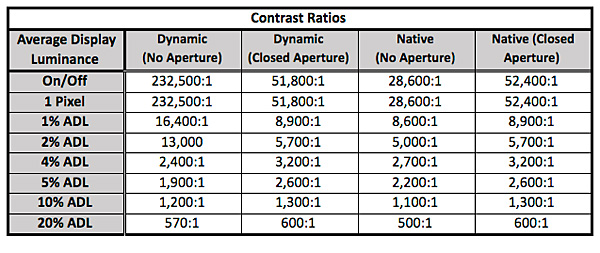I'm not doubting you but Panamorph's website says "Panamorph’s patented new Paladin DCR lens system works with the anamorphic upconversion modes now incorporated into all new Sony and JVC 4K/4096 projectors" but you state "One caveat is that the JVC does not have a proper 16x9 anamorphic mode for use with the Paladin DCR lens." Can you please explain further? Thank you
JVC DLA-NX9 D-ILA Projector Review Test Bench
Measurements were made in a variety of conditions with the bulk taken in the Natural picture preset with the 6500 Color Temperature and REC709 Color Profile settings active. The gamma preset was selected as Custom (2.3). All calibration was done with the dynamic aperture disabled, and contrast ratio measurements were made in a range of different modes as noted. Calibration work was done using a Colorimetry Research CR-100 colorimeter profiled to a Colorimetry Research CR-250 spectroradiometer via CalMAN 2018. Measurements and viewing were carried out using a 140-inch diagonal 2.35:1 Stewart Studiotek 100 screen (1.0 gain).

The full on/off contrast was measured with a Minolta T-10 meter from 1 meter away from the lens face. I tested the projector in various aperture levels with the dynamic mode in Auto 2 for dynamic contrast measurements. Refer to the main review and contrast ratio graph for details on contrast measurements at different average display levels.
RGB tables were captured from a calibration workflow in CalMAN 2018. SDR calibration was measured with REC709 and BT1886 targets.
The JVC's BT.709 color gamut was very good, with no value exceeding a dE of 3. No color management system adjustments were needed after the projector's grayscale was dialed in, with all colors measuring below a dE of 2. Luminance and Saturation values throughout the inner gamut were also very accurate. Grayscale/gamma before calibration had an average dE of 5.4, which was reduced to an average of 1.6 after calibration with no level exceeding a dE of 2. Overall, this represents an excellent level of performance that's comparable to other projectors at this price point. I would like to see JVC add a multi-point grayscale adjustment similar to what we see from flat panels. JVC does offer free auto calibration software, but it requires specific meters and does have a bit of a learning curve for average users.–KRD
- Log in or register to post comments



Was the post calibration 16 ftL achieved using a high or low lamp output?





































































